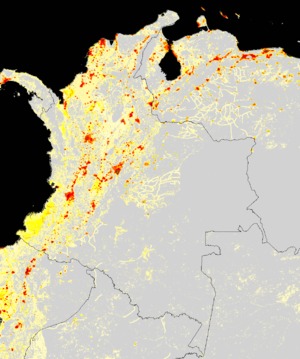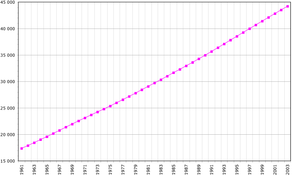- Demographics of Colombia
-
This article is about the demographic features of the population of Colombia, including population density, ethnicity, education level, health of the populace, economic status, religious affiliations and other aspects of the population.
The Demography of Colombia is characterized for being the third-most populous country in Latin America, after Mexico. Colombia experienced rapid population growth like most countries, but four decades of civil war and urban violence combined with mass poverty rates pushed millions of Colombians out of the country. However, a rebound economy in the 2000s in urban centres (perhaps the most urbanized Latin American nation) improved the situation of living standards for Colombians in a traditional class stratified economy.
Urbanization
Movement from rural to urban areas was very heavy in the middle of the twentieth century, but has since tapered off. The urban population increased from 31% of the total population in 1938, to 57% in 1951 and about 70% by 1990. Currently the figure is about 77%. Thirty cities have a population of 100,000 or more. The nine eastern lowlands departments, constituting about 54% of Colombia's area, have less than 3% of the population and a density of less than one person per square kilometer (two people per sq. mi.).
Ethnic diversity
The country has a diverse population that reflects its colourful history and the peoples that have populated here from ancient times to the present. The historic amalgam of three main groups are the basics of Colombia's current demographics: indigenous Amerindians, European immigrants, and African slaves, have intermingled without limitation in its history.
Many of the indigenous peoples were absorbed into the mestizo population, but the remaining 700,000 currently represent over 85 distinct cultures. Today, less than 1% of the population can be identified as fully indigenous on the basis of language and customs. Most of the indigenous population live in the country's flatlands in the south and east.
The European immigrants were Spanish colonists, but many other Europeans (i.e. the Italians, Germans, the French, the Swiss, Poles and Russians). In smaller numbers, Belgian, Lithuanian, Dutch, British, Portuguese and Croatian communities. Most of the Europeans immigrated during the Second World War (1939–1945) and the Cold War (1945–1990) as well fleeing the Spanish Civil War of the 1930s.
Other immigrant populations include Asians and Middle Easterners, particularly Arabs (esp. Lebanese and Syrians), Chinese, Japanese, Koreans, Southeast Asians (esp. Vietnam after the end of the Vietnam War), Armenians arrived in large numbers after World War I, and East Indians or Pakistanis settled in Colombia. The Venezuelan population is increasing in Bogotá, Bucaramanga, Cali, Cúcuta, Medellín, Santa Marta and Cartagena de Indias.
In the 1990s and 2000s, about half a million immigrants from Europe and North America (mainly the United States) usually are retired came to settle in urban areas and coasts of Colombia. It is not a new phenomenon, when about 5,000 Americans settled the Caribbean region in the late 19th century.[citation needed]
 Afro-Colombian children. Most of the Afro-Colombian population is concentrated in the Department of Chocó, region facing the Pacific Ocean.
Afro-Colombian children. Most of the Afro-Colombian population is concentrated in the Department of Chocó, region facing the Pacific Ocean.
The Africans were brought as slaves, mostly to the coastal lowlands, beginning early in the sixteenth century, and continuing into the nineteenth century. After abolition, a national ideology of mestizaje encouraged the mixing of the indigenous and white people into a single mestizo ethnic identity [2].
Colombian culture, cuisine, music and social life are from the polyglot ethnic and racial balance. One famous Colombian emigrant, pop music singer Shakira of Barranquilla is herself of Italian, French and Lebanese ancestry.
Migration
By 2006, Colombia has accumulated millions of internally displaced persons. At least 1.5 million of them are registered in the government's databases. NGOs and others estimate that the actual number could be as high 2 to 3 million, which would be the highest number of any country in the western hemisphere, and second worldwide, after Sudan. Most of the displaced do not live in camps, but rather disperse themselves throughout Colombia's own cities, an estimated 40% in the ten largest urban areas. [3].
In recent years, the main destination for those Colombians that have left their nation for economic reasons and the effects of the internal conflict has been neighboring Venezuela and other Latin American countries, including Argentina, Brazil, Chile, Costa Rica, Ecuador, Mexico, Panama and Peru. (see Colombian diaspora).
Historically, a sizable percentage of Colombian emigration has also been motivated by the need to escape from political persecution and bipartisan violence during the periods of "La Violencia" (1948–1958), and later due to the effects of the nation's current conflict (since 1964). This has resulted in numerous applications for political asylum abroad.
Colombians have emigrated in comparably high rates to the United States (esp. to Miami, Florida, the largest Colombian American community). Colombian enclaves appeared in New Jersey, New York City, Chicago, Washington, D.C. and California being L.A. and San Francisco. Other Colombians migrated to Canada and Europe (most to Spain, but also to France and Italy, and the United Kingdom, which has a sizable Colombian community in London). Tens of thousands went to Japan and even a few thousand to Australia, among other locations.[citation needed]
2005 Census
According to the 2005 census, there are 45,421,609 Colombians in the world (42,090,502 living in the national territory and 3,331,107 living abroad).
# Department Capital Area Population 1 Amazonas Leticia 109,665 km² 56,036 2 Antioquia Medellín 63,612 km² 5,671,689 3 Arauca Arauca 23,818 km² 208,605 4 Atlántico Barranquilla 3,388 km² 2,112,128 5 Bogotá, Distrito Capital Bogotá 1,587 km² 6,778,691 (not metropolitan) 6 Bolívar Cartagena 25,978 km² 1,860,445 7 Boyacá Tunja 23,189 km² 1,211,186 8 Caldas Manizales 7,888 km² 908,841 9 Caquetá Florencia 88,965 km² 404,896 10 Casanare Yopal 44,640 km² 282,452 11 Cauca Popayán 29,308 km² 1,244,886 12 Cesar Valledupar 22,905 km² 879,914 13 Chocó Quibdó 46,530 km² 441,395 14 Córdoba Montería 25,020 km² 1,472,699 15 Cundinamarca Bogotá 24,210 km² 2,228,478 (without Bogotá) 16 Guainía Inirida 72,238 km² 30,232 17 Guaviare San José del Guaviare 53,460 km² 81,411 18 Huila Neiva 19,890 km² 1,006,797 19 La Guajira Riohacha 20,848 km² 623,250 20 Magdalena Santa Marta 23,188 km² 1,136,901 21 Meta Villavicencio 85,635 km² 789,276 22 Nariño Pasto 33,268 km² 1,531,777 23 Norte de Santander Cúcuta 21,658 km² 1,228,028 24 Putumayo Mocoa 24,885 km² 299,286 25 Quindío Armenia 1,845 km² 518,691 26 Risaralda Pereira 4,140 km² 863,663 27 San Andrés and Providencia San Andrés 52 km² 59,573 28 Santander Bucaramanga 30,537 km² 1,916,336 29 Sucre Sincelejo 10,670 km² 765,285 30 Tolima Ibagué 23,562 km² 1,335,177 31 Valle del Cauca Cali 22,140 km² 4,060,196 32 Vaupés Mitú 54,135 km² 27,124 33 Vichada Puerto Carreño 100,242 km² 55,158 Total 1,141,748 km² 42,090,502 CIA World Factbook demographic statistics
The following demographic statistics are from the CIA World Factbook, unless otherwise indicated.[1]
Population
44,725,543 (July 2011 est.)
Age structure
- 0–14 years: 30.3% (male 6,683,079/female 6,528,563)
- 15–64 years: 64.5% (male 13,689,384/female 14,416,439)
- 65 years and over: 5.2% (male 996,022/female 1,279,548) (2006 est.)
- 0–14 years: 27.2% (male 6,150,834/female 5,876,697)
- 15–64 years: 66.8% (male 14,562,536/female 14,967,492)
- 65 years and over: 6% (male 1,125,184/female 1,522,550) (2010 est.)
Median age
total: 27.6 years
male: 26.7 years
female: 28.6 years (2010 est.)
Population growth rate
- 1.433% (2007 est.)
- 1.184% (2010 est.)
Birth rate
20.16 births/1,000 population (2007 est.)
17.76 births/1,000 population (2010 est.)
Death rate
5.54 deaths/1,000 population (2007 est.)
5.24 deaths/1,000 population (July 2010 est.)
Net migration rate
-0.69 migrant(s)/1,000 population (2007 est.)
-0.68 migrant(s)/1,000 population (2010 est.)
Sex ratio
At birth: 1.03 male(s)/female
Under 15 years: 1.02 male(s)/female
15–64 years: 0.95 male(s)/female
65 years and over: 0.75 male(s)/female
total population: 0.96 male(s)/female (2009 est.)
Infant mortality rate
total: 16.8 deaths/1,000 live births
Life expectancy at birth
total population: 74.31 years
male: 70.98 years
female: 77.84 years (2010 est.)
Total fertility rate
- 2.54 children born/woman (2006 est.)
- 2.18 children born/woman (2010 est.)
- 2.15 children born/woman (2011 est.)
HIV/AIDS - adult prevalence rate
0.6% (2007 est.)
HIV/AIDS - people living with HIV/AIDS
170,000 (2007 est.)
HIV/AIDS - deaths
9,800 (2007 est.)
Nationality
noun: Colombia adjective: Colombian(s)
Ethnic groups
According to the 2005 census by the DANE the population of Colombia was composed of these ethnic groups:[2]
- 58% Mestizo (European and Amerindian).
- 20% White (European).
- 14% Mulatto(European and Black/African).
- 4% Afro-Colombian.
- 3% Zambo (African and Amerindian).
- 1% Amerindian.
Other ethnic groups include Arabs counted with the Whites (Lebanese, Palestinians and Syrians), Chinese, Roma or Gypsies from Eastern Europe, and South Asians (East Indians).[citation needed]
Religions
Roman Catholic 90%, Other 10% (Protestant, Eastern Orthodox, Mormon, Jewish and Muslim).
Languages
Spanish (3rd largest population of Spanish speakers after Mexico and Spain), the official language, small communities of European languages, such as German, French, English, Italian and Portuguese in urban areas. There are 65 indigenous languages and two Creole languages: one in San Basilio de Palenque and one in San Andrés. There are 79,000 speakers of Romani in Colombia.[4]
Literacy
definition: age 15 and over can read and write
total population: 90.4%
male: 90.1%
female: 90.7% (2005 census)
References
- ^ The World Factbook - Colombia
- ^ [1] (Spanish) DANE: 2005 Census
 This article incorporates public domain material from the CIA World Factbook document "2006 edition".
This article incorporates public domain material from the CIA World Factbook document "2006 edition".
External links
- (Spanish) Colombian Department of Statistics
- (Spanish) 1951 Census
 Colombian people
Colombian peopleIn Colombia Diaspora Demographics of South America Sovereign states Dependencies and
other territories- Aruba
- Bonaire
- Curaçao
- Falkland Islands
- French Guiana
- South Georgia and the South Sandwich Islands
Categories:- Colombian society
- Demographics of Colombia
Wikimedia Foundation. 2010.


